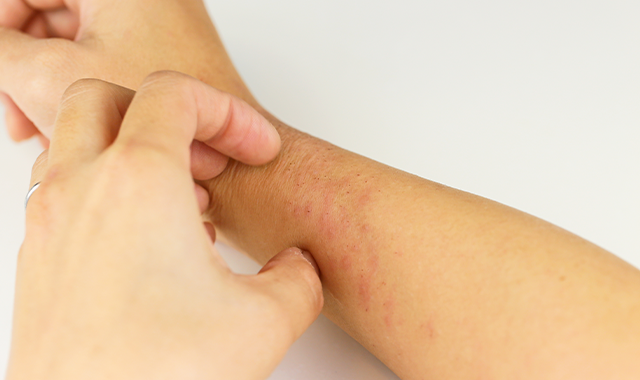
- Case-Based Roundtable
- General Dermatology
- Eczema
- Chronic Hand Eczema
- Alopecia
- Aesthetics
- Vitiligo
- COVID-19
- Actinic Keratosis
- Precision Medicine and Biologics
- Rare Disease
- Wound Care
- Rosacea
- Psoriasis
- Psoriatic Arthritis
- Atopic Dermatitis
- Melasma
- NP and PA
- Skin Cancer
- Hidradenitis Suppurativa
- Drug Watch
- Pigmentary Disorders
- Acne
- Pediatric Dermatology
- Practice Management
- Prurigo Nodularis
- Buy-and-Bill
Article
Shared decision-making for treating atopic dermatitis
Author(s):
Atopic dermatitis patients are likely more willing to adhere to treatment and achieve better outcomes when there is shared decision-making between the clinician and patient, according to an article in press in the Annals of Allergy, Asthma and Immunology.
Atopic dermatitis patients are likely more willing to adhere to treatment and achieve better outcomes when there is shared decision-making between the clinician and patient, according to an article in press in the Annals of Allergy, Asthma and Immunology.
“The bottom line is that we need to be moving in our practice, when possible, to shared decision-making (SDM),” states first author Michael Blaiss, M.D., of the Medical College of Georgia at Augusta University. “We need to get away from the paternalistic physician who says to the patient ‘take this’ and ‘this is what you do.’”
On the other hand, clinicians should not have to compete with Dr. Google, in which patients come into the office insisting on a particular treatment that they have seen advertised on TV or the Internet.
“Instead, we want to develop a dialogue,” Dr. Blaiss tells Dermatology Times. “We want to provide patients with non-biased information related to their particular disease and a particular treatment.”
Moreover, clinicians should solicit from their patients information about their beliefs and values related to their disease and treatment.
“Hopefully, we can then come together in a shared spirit to devise a medical plan that meets the needs of both the physician and the patient,” says Dr. Blaiss, executive medical director of the American College of Allergy, Asthma and Immunology (ACAAI).
Dr. Blaiss notes that there are data for other disease states like asthma and diabetes that clearly shows that SDM improves patient satisfaction, quality of life and outcomes. “We also attain better adherence when that patient has a buy-in to the treatment,” he says.
Dr. Blaiss says atopic dermatitis is a prime condition for SDM because of the number of effective treatments, thus the heightened need for patient buy-in. “Most treatments for atopic dermatitis require a lot of work and are usually applied daily,” he says.
The SDM tool for atopic dermatitis was developed over about a six-month period by a team of allergists and dermatologists, starting in early 2018 and released in August. Previously, the developers made available similar aids for allergen immunotherapy and severe asthma in adults.
The SDM model divides atopic dermatitis patients into two groupsâmild to moderate and moderate to severeâbased on patient history, physical exam and previous treatments.
The patient than evaluates the various treatments for the type of severity. Factors considered for each treatment option include benefits, risks, side effects, how the treatment is applied, the duration of therapy and cost.
Afterward, the patient is asked to agree or disagree to a series of statements that will closely align patient values and beliefs to each specific treatment. Among the statements:
• “I have eczema on a large part of my body.”
• “I find it difficult to apply topical treatments to my eczema every day.” “I do not like the idea of using steroids.”
• “I would like to try newer medication.”
• “I would rather use a medication that has the longest safety record.”
• “I am willing to pay more for a medication that is newer.”
The developers debated whether patients should answer such statements on a scale as opposed to a simple yes or no. “For allergen immunotherapy, we used a scale,” Dr. Blaiss says. “However, we found out that answering yes or no is probably good enough.”
The SDM model is not to replace a doctor, stresses Dr. Blaiss. “This is a tool a patient uses with the doctor,” he says. “The doctor is still going to ask the patient questions and look at the answers in order to dive deeper.”
Because of the time commitment for patients to take care of their atopic dermatitis, it is important that clinicians understand what patients will and will not do, and what patients find happy and unhappy about treatment. “Also, what fits into their lifestyle and what fits into their beliefs,” Dr. Blaiss says.
By patients embracing SDM, they receive an excellent education on treatments, according to Dr. Blaiss. “Patients are also able to make some decisions that can hopefully help the physician attain a better outcome,” he says.
Dr. Blaiss shatters the myth that incorporating SDM takes more time in the office. “By having tools like this, the patient can use it at home and then return to the office to discuss findings with the doctor,” he says. “In fact, in certain ways SDM helps take some of the burden off the physician.”
REFERENCE
Blaiss MS, Steven GC, Bender B, et al. “Shared Decision Making for the Allergist,” Annals of Allergy, Asthma and Immunology, 2018. In press
2 Commerce Drive
Cranbury, NJ 08512
All rights reserved.





